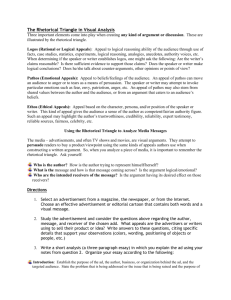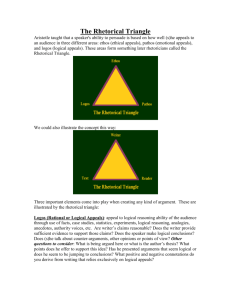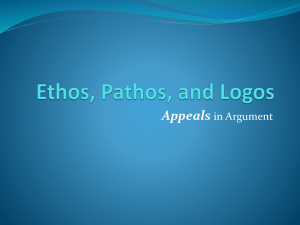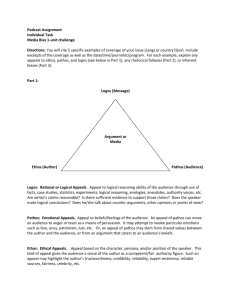Advertisements and the Rhetorical Triangle
advertisement
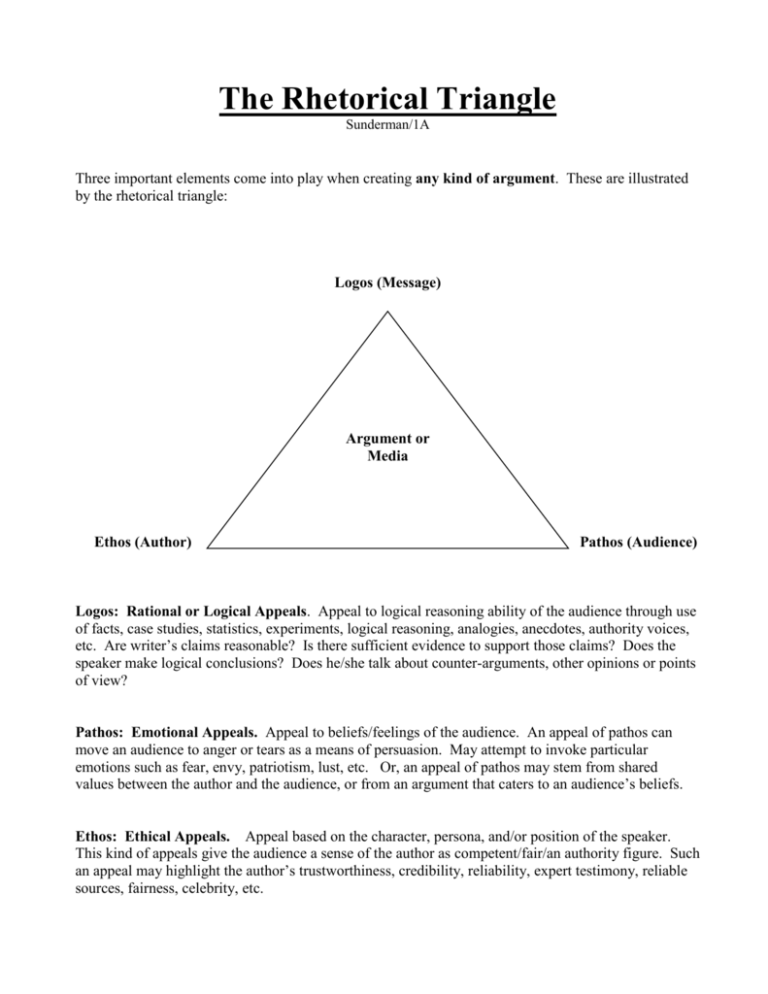
The Rhetorical Triangle Sunderman/1A Three important elements come into play when creating any kind of argument. These are illustrated by the rhetorical triangle: Logos (Message) Argument or Media Ethos (Author) Pathos (Audience) Logos: Rational or Logical Appeals. Appeal to logical reasoning ability of the audience through use of facts, case studies, statistics, experiments, logical reasoning, analogies, anecdotes, authority voices, etc. Are writer’s claims reasonable? Is there sufficient evidence to support those claims? Does the speaker make logical conclusions? Does he/she talk about counter-arguments, other opinions or points of view? Pathos: Emotional Appeals. Appeal to beliefs/feelings of the audience. An appeal of pathos can move an audience to anger or tears as a means of persuasion. May attempt to invoke particular emotions such as fear, envy, patriotism, lust, etc. Or, an appeal of pathos may stem from shared values between the author and the audience, or from an argument that caters to an audience’s beliefs. Ethos: Ethical Appeals. Appeal based on the character, persona, and/or position of the speaker. This kind of appeals give the audience a sense of the author as competent/fair/an authority figure. Such an appeal may highlight the author’s trustworthiness, credibility, reliability, expert testimony, reliable sources, fairness, celebrity, etc. Using the Rhetorical Triangle to Analyze Media Messages The media – advertisements, and often TV shows and movies, are visual arguments. They attempt to persuade readers to buy a product/viewpoint using the same kinds of appeals authors use when constructing a written argument. So, when you analyze a piece of media, it is important to remember the rhetorical triangle. Ask yourself: Who is the author? How is the author trying to represent himself/herself? What is the message and how is that message coming across? Is the argument logical/emotional? Who are the intended receivers of the message? Is the argument having its desired effect on those receivers? Specific Questions to Consider (No, not necessarily all at once…): The Author Who is the author? Is it a business firm trying to sell you a product or a service, a public organization seeking to inform you about its policies, a politician trying to win your allegiance, an interest group or media member trying to change your opinion about an issue? Other? What is the ethos (general credibility) of the author? What is the ad trying to accomplish? In other words, what is the sender’s “problem?” There is often some kind of communication problem behind an ad or campaign. For example, the authors may seek more awareness on the part of the receiver, or more legitimacy for themselves. Are you aware of any problems the sender (company) may be having within that specific industry, market, or area of activity? The Message What is the simple message of the media? What product is the ad trying to sell? What is the subject of the movie/TV show? What is the true message of the media? Are there any hidden meanings the receiver is intended to observe? Do any connotations come to mind when you view the media? What ideologies or values does the piece of media invoke? In other words, what images, discourses, concepts, myths, etc. of the culture does the media use when making an appeal? How is the message presented? In an advertisement, what is the layout? What images, text appear, etc.? If it is a TV Show or movie, who are the characters? What is the setting, etc? How does the media connect concrete features with abstract values? In other words, how does the presentation of the message communicate deeper/abstract meanings (our values/norms) in addition to the simpler meaning (what is being sold)? The Receiver Who is the targeted audience? What individuals/group of individuals is/are intended to receive the message? Is the media having the desired affect on the targeted audience? Are the logical/emotional/ethical appeals working? Is the audience being persuaded to buy what the media/advertisers are selling? If yes, why? If not, why not? If the desired message comes across effectively, might there be any consequences for the receivers? For society as a whole? In-Class Activity: Break students into small groups of 3 or 4, and ask each group to elect a recorder and a presenter. Teacher comes prepared with several ads from magazines, newspapers, etc. for students to analyze. Hand out one advertisement to each group, and ask them to consider the questions above regarding the author, message, and receiver of their chosen ad. They should also consider what appeals the advertisers are using to sell their product. The recorder should note down the most important points discussed by the group. The presenter should present the group’s ideas to the class.





